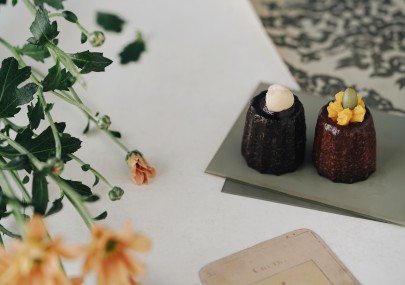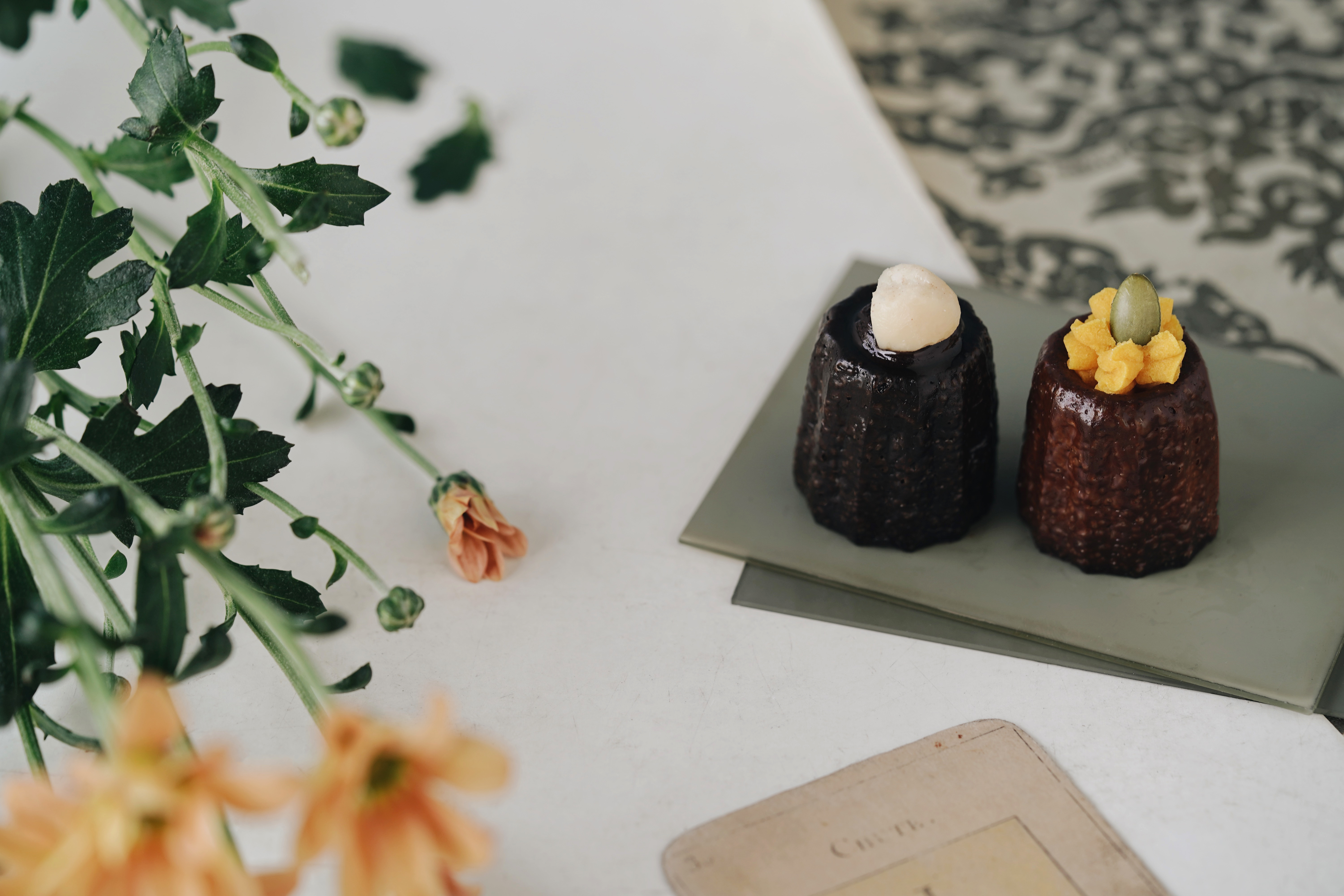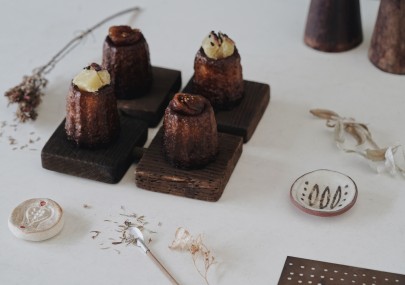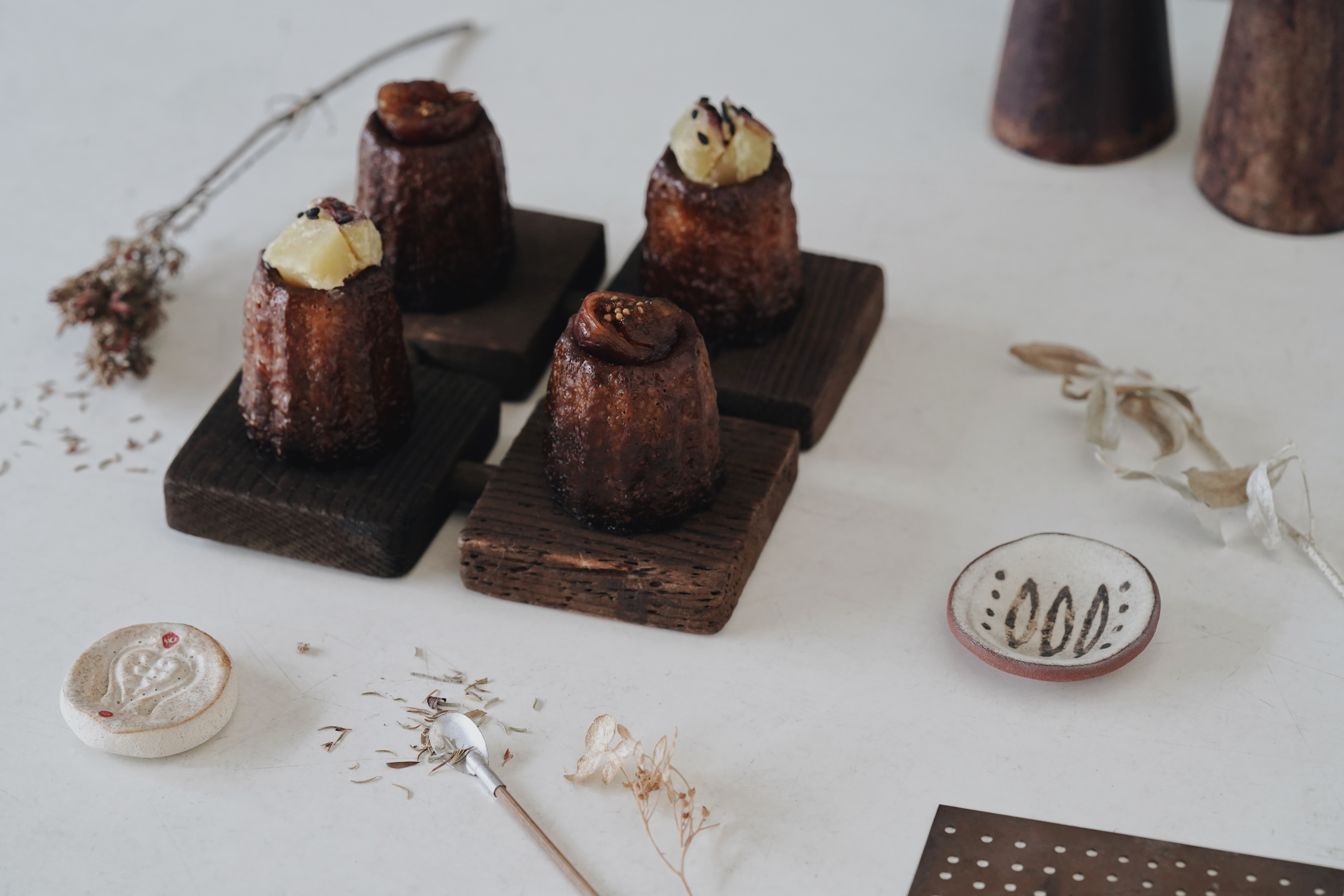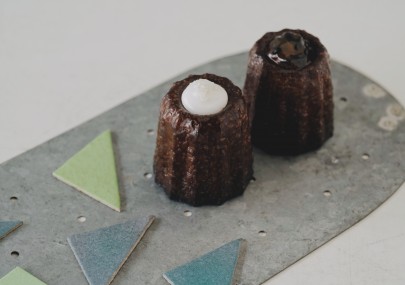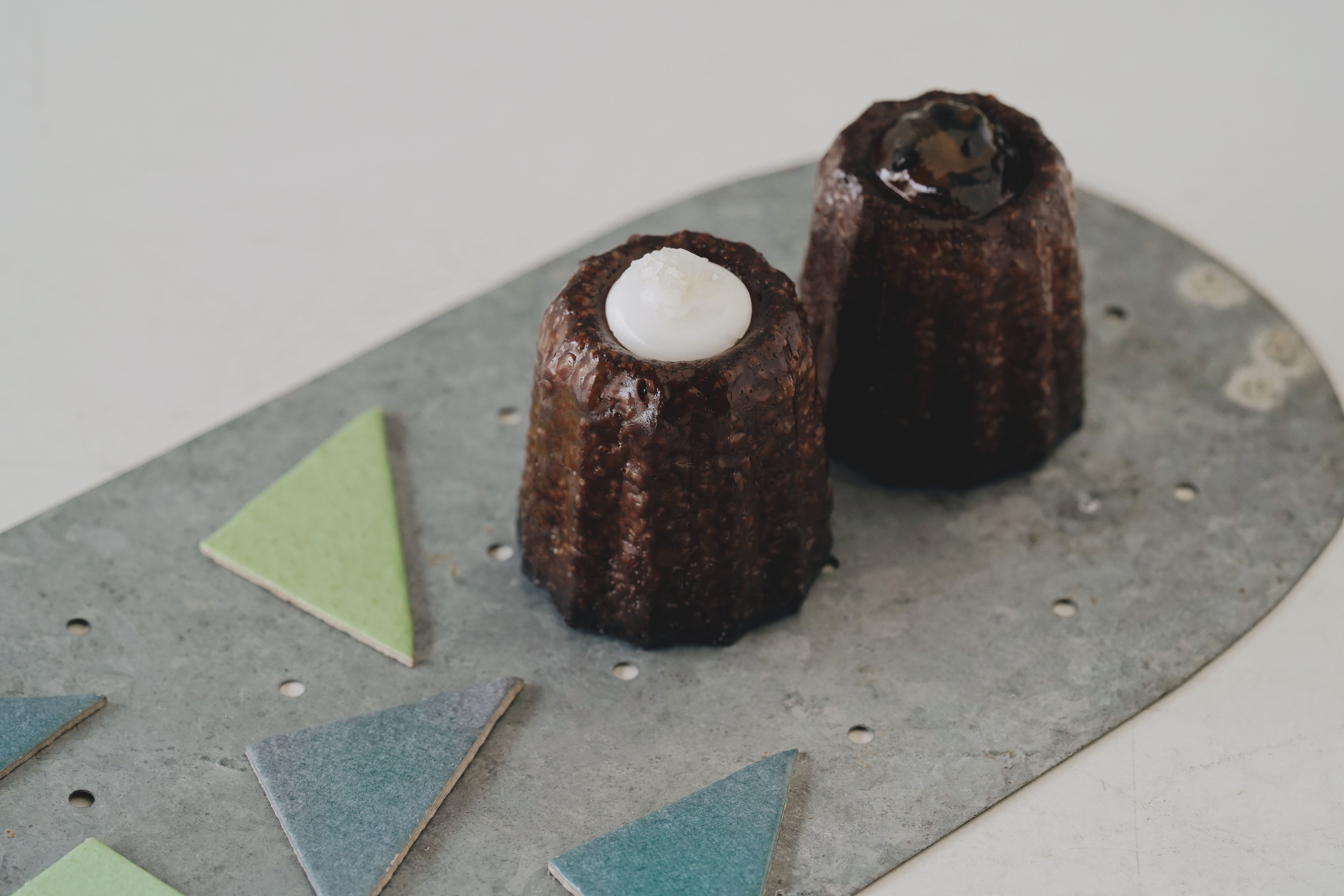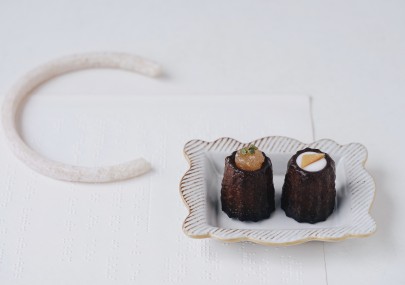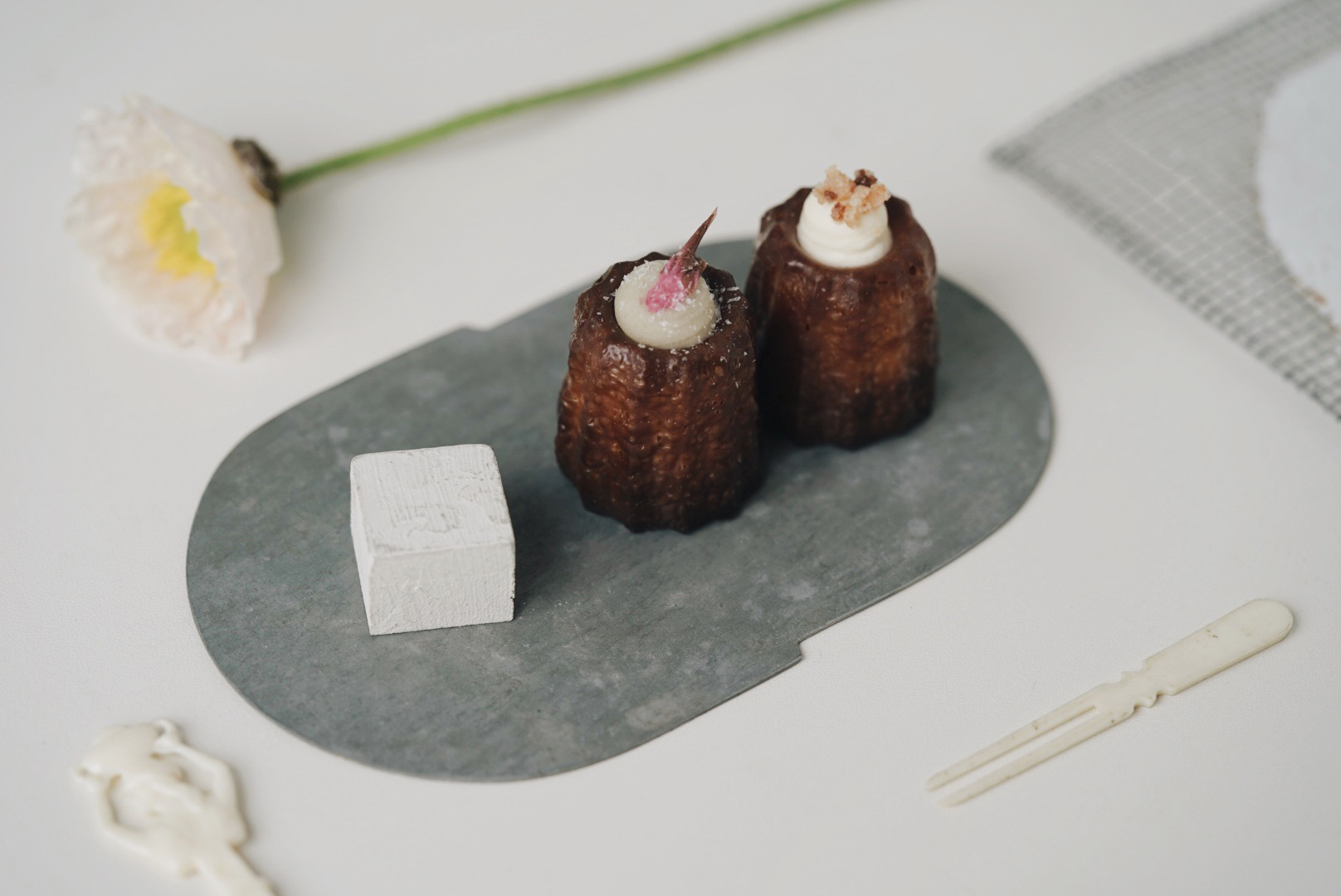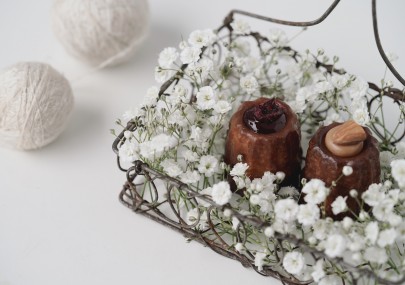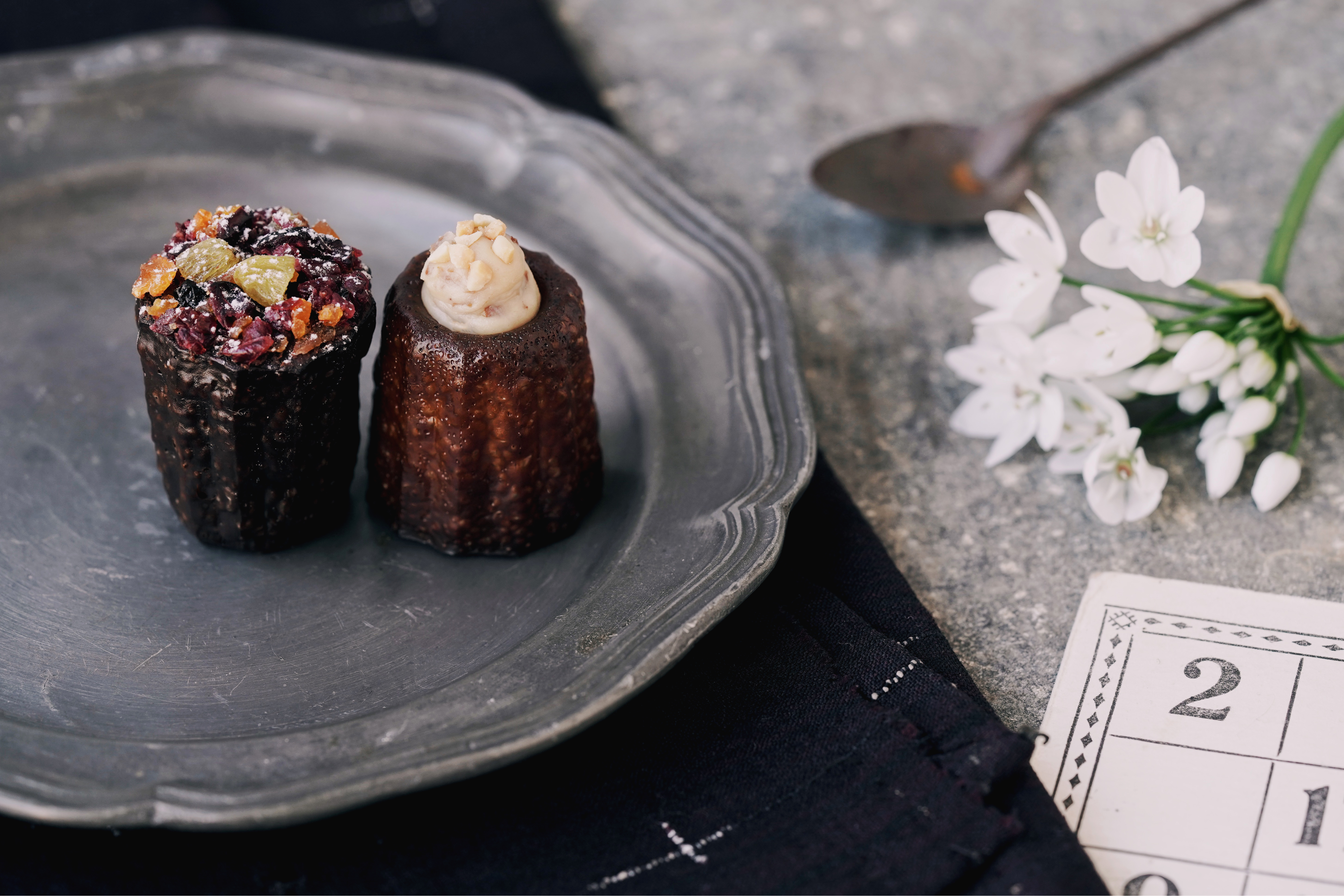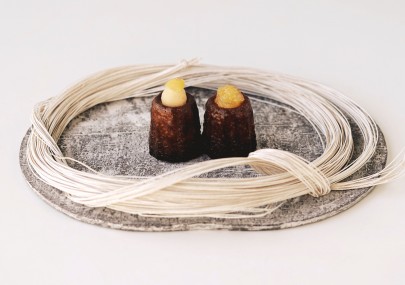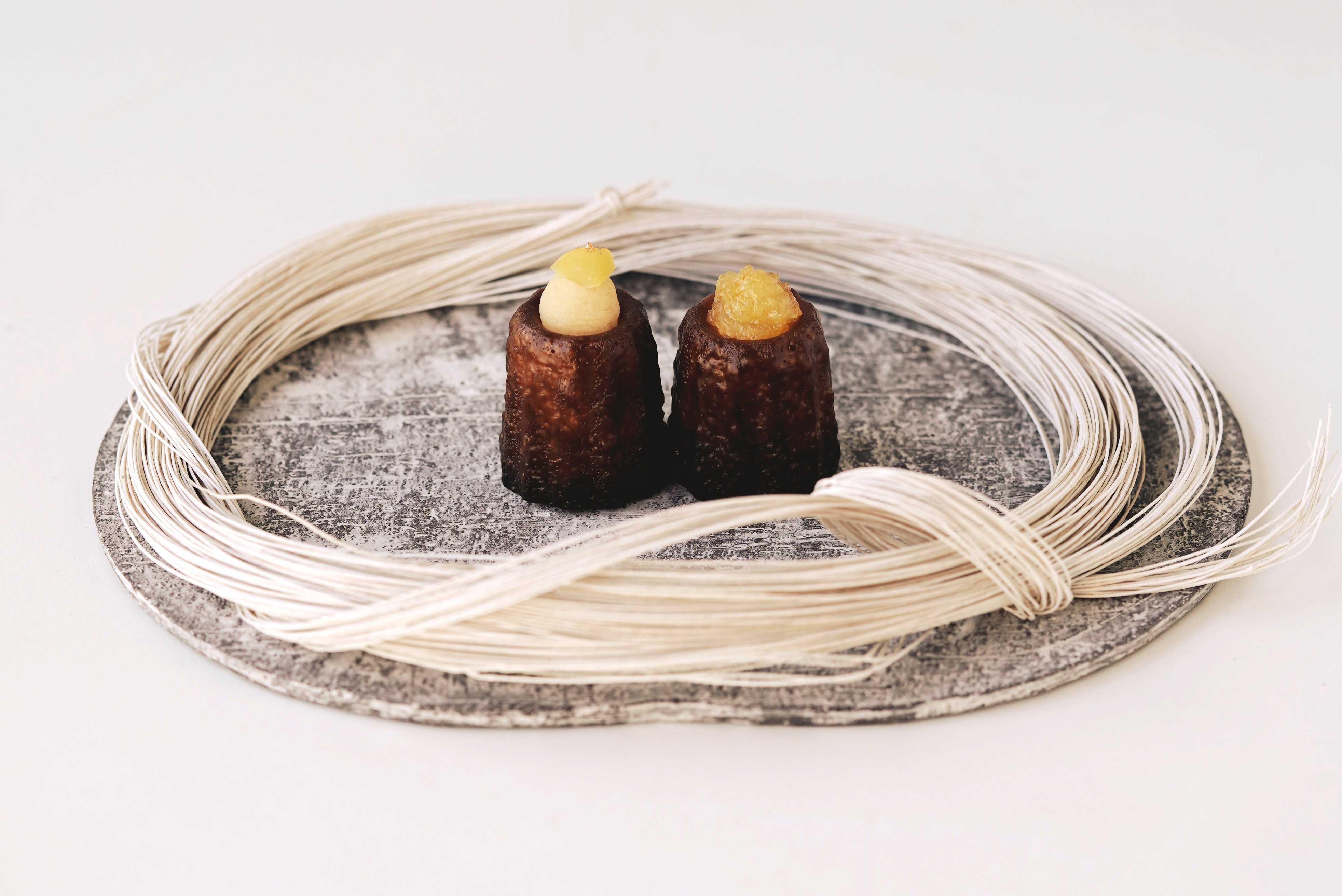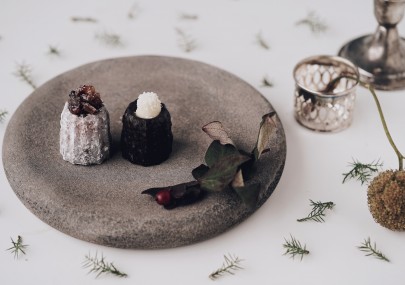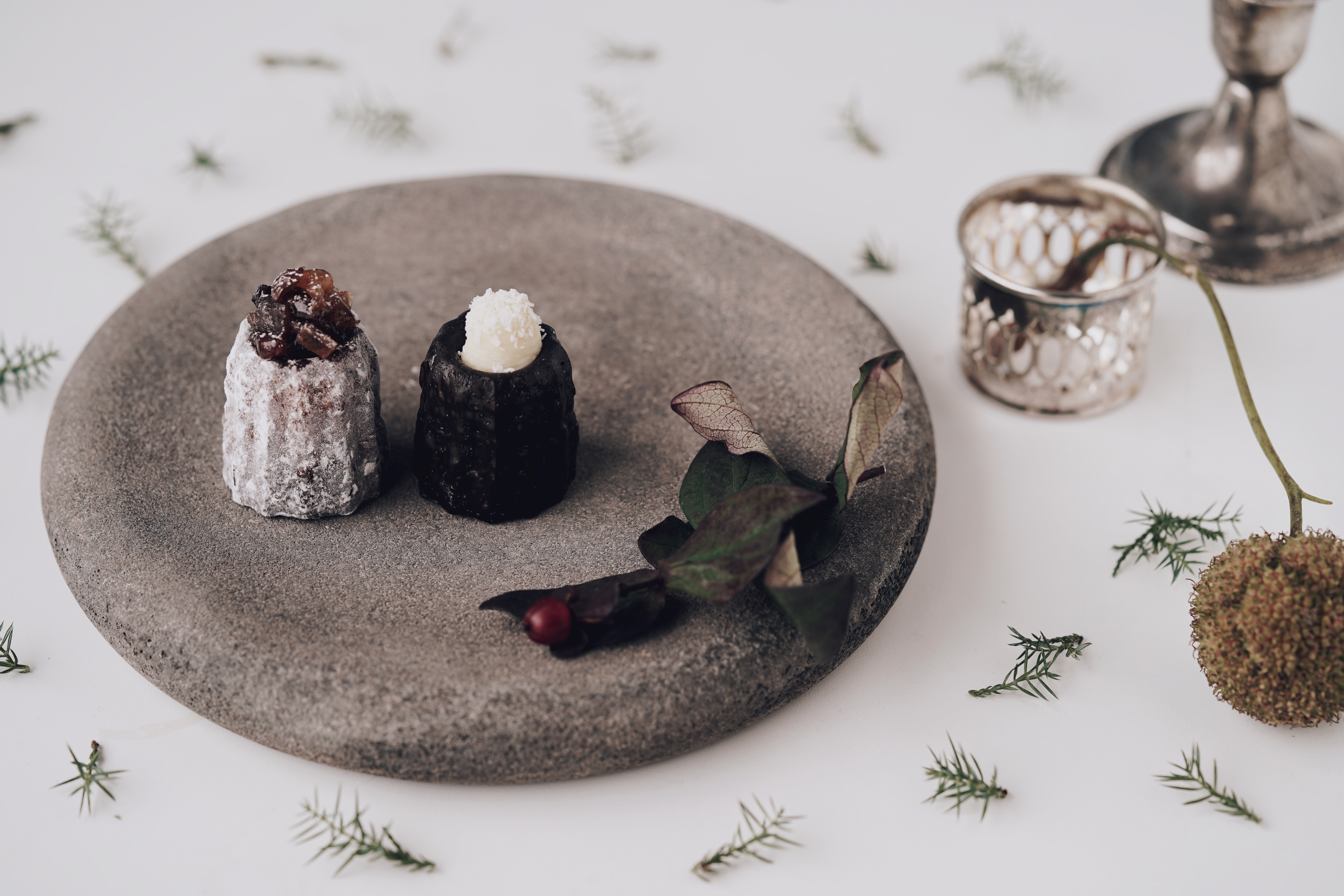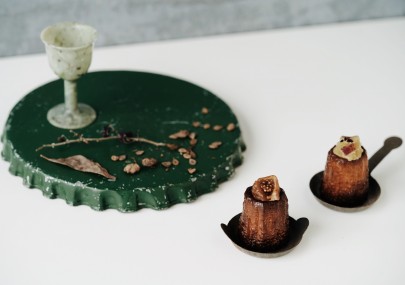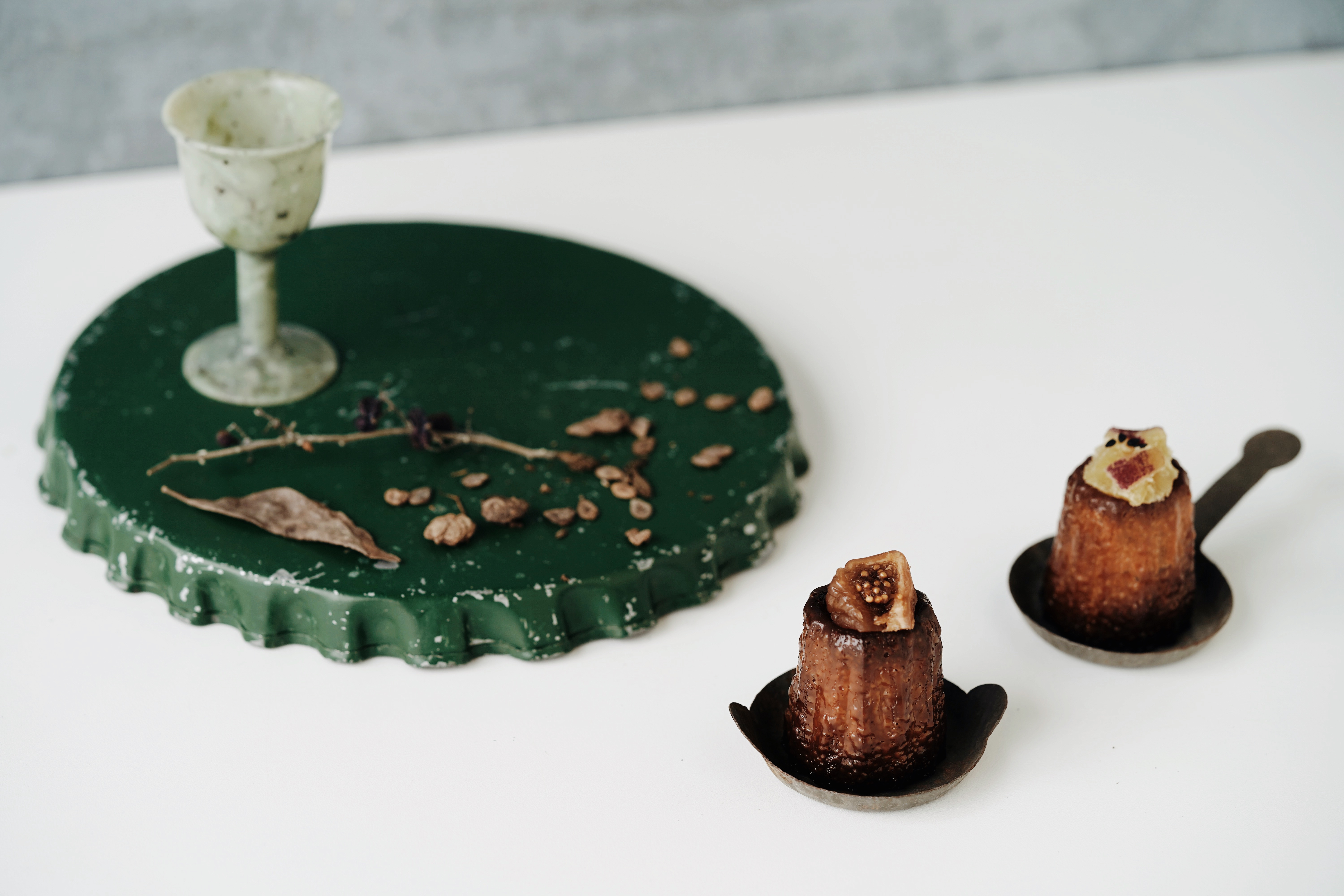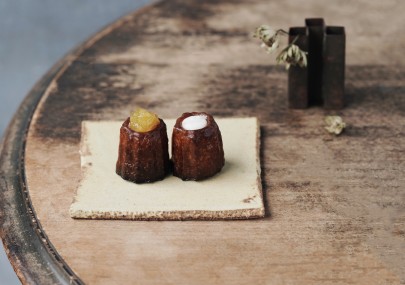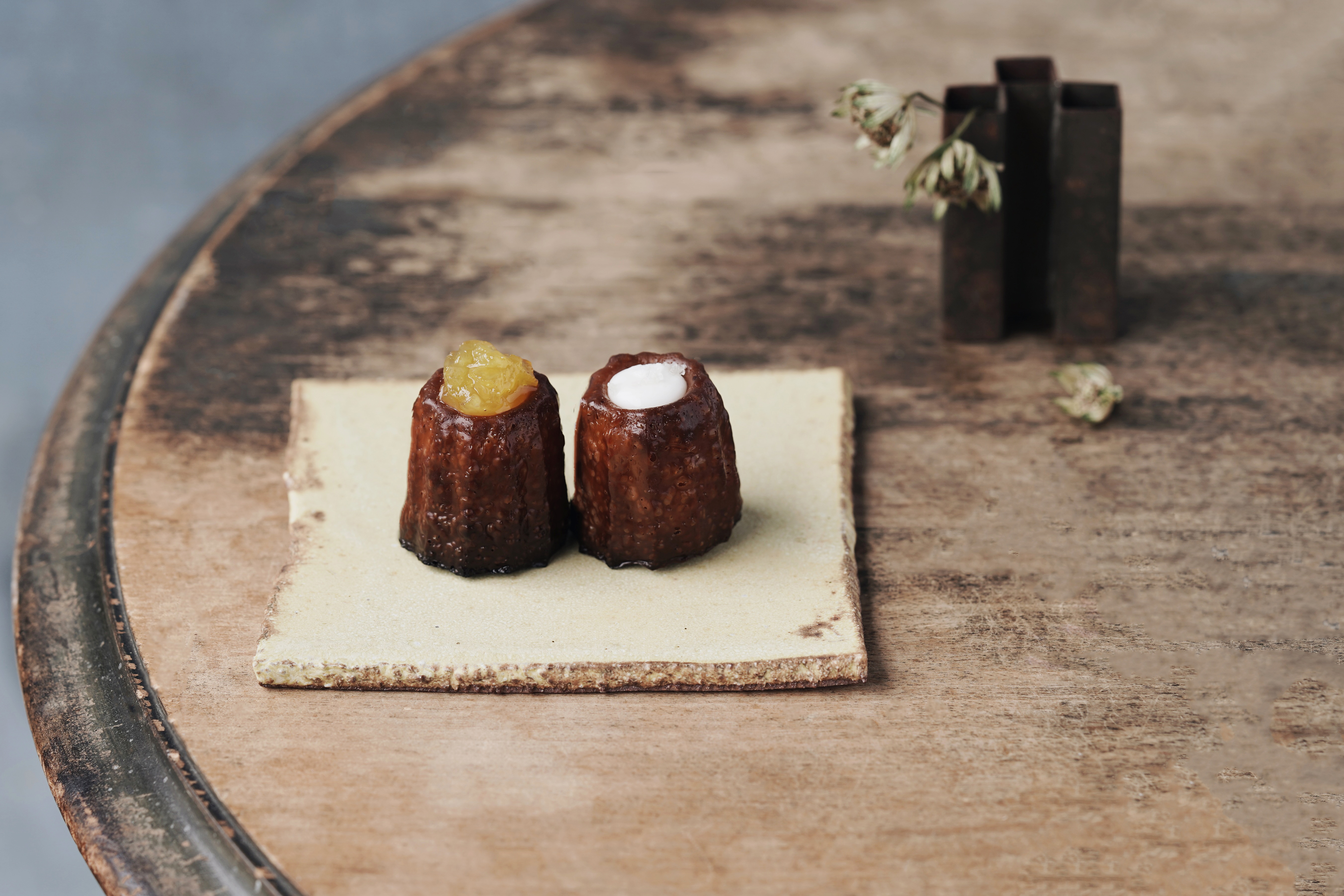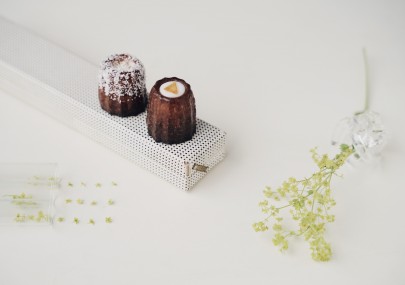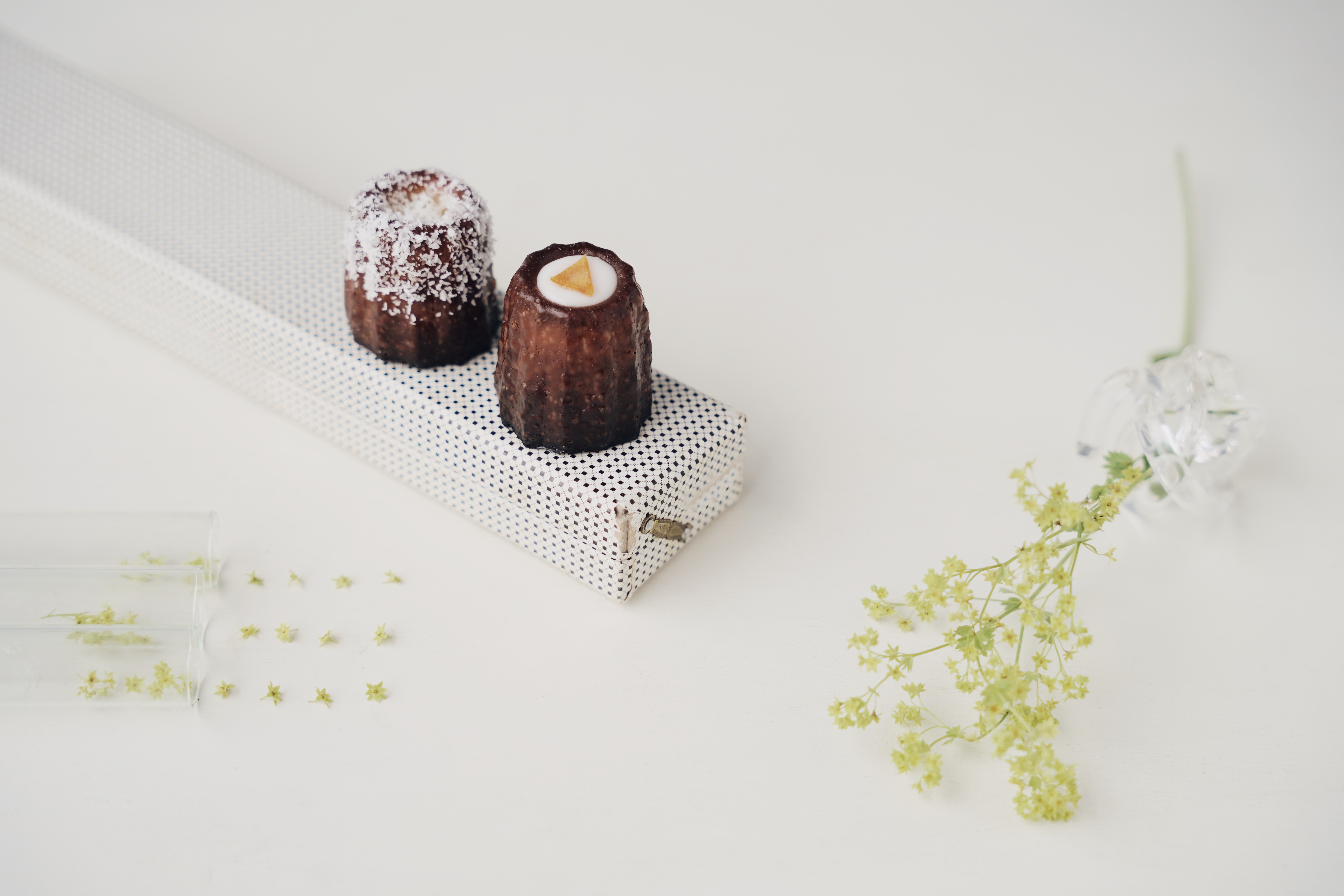-
Les canelés de saison | “Citrouille” et “Chocolat aux noix”
The fragrance of the osmanthus has begun to waft through the air. The lingering summer heat has been severe year after year, and many of you may have been looking forward to the autumn season. The phrase “three autumns in one day” symbolizes anticipation. Because you have a strong feeling toward your partner, it feels as if three autumns have passed when you cannot see them. The pleasant season always seems to pass in an instant. Autumn is an excellent season for enjoying food, reading, art, sports, etc. Let’s enjoy this autumn to the fullest. Our seasonal canelés for this month, “Pumpkin” and “Nuts Chocolat” are available from today, the 1st of October. Pumpkin canelés are decorated with pumpkin seeds with pumpkin paste on top of pumpkin dough. The tender sweetness of pumpkin is concentrated in each canelé, and they are perfect for autumn. Nuts Chocolat canelés are with cashew nuts and macadamia nuts in the chocolate dough, decorated with chocolate ganache and dolled up with macadamia nuts. Please enjoy how smooth the chocolate melts in your mouth and the texture of the two kinds of nuts.
金木犀の香りが漂いはじめました。年々残暑も厳しく、秋が待ち遠しかった方も多いのではないでしょうか。「一日三秋」は、とても待ち遠しいことのたとえです。一日に三度も季節が廻って秋が訪れるかのように、今か今かと待ち望み、相手を恋しく思う気持ちが深いことを言います。心地いい季節はいつも一瞬で過ぎ去っていくように思います。食欲の秋、読書の秋、芸術の秋、スポーツの秋…この季節だからこそできることを存分に楽しみたいものです。10月の季節のカヌレは「かぼちゃ」と「ナッツショコラ」が、本日10月1日(火)よりお目見えです。「かぼちゃ」はかぼちゃの生地にお手製のかぼちゃ餡をしぼり、かぼちゃの種をのせました。かぼちゃのやさしい甘みがぎゅっと詰まった秋の定番の一品です。「ナッツショコラ」はショコラ生地の中に、カシューナッツとマカダミアナッツを入れ、上にショコラガナッシュを絞りマカダミアナッツをごろっとのせました。チョコレートの口溶けと2種のナッツの食感をお楽しみください。
-
Les canelés de saison | “Patate douce” et “Figues”
The sun is setting earlier and earlier day by day, and we are beginning to feel the autumn in the wind. Have you ever heard of the Kannamesai, the celebration and thanksgiving for a plentiful harvest by offering the year’s first harvest to Amaterasu? This is considered the most important of the 1,500 annual festivals held at Ise Jingu. It is also known as the “New Year of the Shrine” because the ritual utensils are renewed at the Ise Jingu Shrine for the Kanamesai. It may be one of the precious events for the Japanese as rice has been our main diet for many years. In the harvest season of autumn, we will take time to savor this year’s new rice and harvest delicacies with deep respect and gratitude for nature, which the Japanese people have cherished, and that alone will enrich our hearts and minds. Our pair of seasonal canelés for this month, “Sweet potato” and “Fig” are available from today, September 1st. The sweet potato canelés are candied sweet potatoes wrapped in sweet potato dough and topped with the same filling and sesame sprinkled on top. The sweetness fills your mouth with a soft, luscious flavor. Fig canelés are filled with dried fig compote in red wine and cinnamon-flavored dough. The popping texture of fig and refined afternote of red wine would be delightful.
少しずつ日暮れの時間が早くなり、秋の気配を感じるようになりました。五穀豊穣に感謝して、その年にとれた初穂を最初に天照大御神にささげる祭、神嘗祭(かんなめさい)をご存知ですか?年間1500回にも及ぶ伊勢神宮恒例のお祭りの中でも、最も重要なお祭りです。神嘗祭のとき、伊勢神宮では祭器具が一新されることから「神宮の正月」ともいわれています。お米をいただく日本人ならば知っておきたい行事です。実りの秋の季節、日本人が大切にしてきた自然に対する深い敬意と感謝の気持ちで、今年の新米や秋の味覚をじっくり味わう、それだけで心豊かになりそうです。9月の季節のカヌレは「さつまいも」と「いちじく」が、本日9月1日(日)よりお目見えです。「さつまいも」はさつまいもの甘露煮をさつまいもの生地で包み、上にものせ、最後にごまを散らしました。さつまいものやさしい甘さがお口いっぱいに広がります。「いちじく」は赤ワインとシナモンの生地の中に、イチジクのコンポートを入れ、上にものせました。イチジクのプチプチ食感と赤ワインの大人な余韻をお楽しみください。
-
Les canelés de saison | “Fleur de sel de Guérande” et “Fruit de la passion”
It is the time of year for fireworks, which are a summer tradition and representative of the beauty of Japan. Among fireworks, Senko-Hanabi, or Japanese sparkers, have always captured the hearts of the Japanese because of their fleeting beauty. Do you know that each stage of a firework has its own name, from when it’s lit to fall? It starts with “bud” as the fireball gradually grows larger until it becomes “peony” with short sparkles begin to burst one by one. It then makes “pine needles” by gaining momentum, and the sparks spread in all directions till eventually it gets softened as sparkles get thinner and drop slightly like “willow.” The final part is “scattering chrysanthemum,” in which the sparks fall one by one till the last. Japanese people may see their own lives in how short-lived fireworks burn beautifully. Our pair of seasonal canelés for this month, “Salt of Guérande” and “Passion Fruits” are available from today, August 1st. The Salt of Guérande canelés are made with salty dough flavored with “fruits of the sea” or salt of Guérande, France. Please enjoy the fresh afternote spreading as the mild saltiness gently brings out its sweetness. Passion fruit canelés have the paste of the sweet white bean and passion fruits inside the apricot dough, dolled up with homemade jam made from the passion fruits from Amami-Oshima on top. The refreshing sweetness and sourness of passion fruit will bring you tropical island vibes.
花火大会が開催される時期になりました。夏の風物詩、日本の美の代表格とも言える花火の中でも、線香花火はその儚さから、日本人の心を掴んでやみません。火をつけてから火の玉が落ちるまでの段階にそれぞれ名前があるのを知っていますか?点火から次第に大きくなっていく火の玉を花が咲く前に見立てた「蕾」、パチパチと短い火花がひとつずつ弾けはじめるまでを「牡丹」、勢いを増し火花が四方八方に広がっていく「松葉」、火花の勢いが衰え、火花は細く、やや垂れ下がる「柳」、火花が一本、また一本と落ちていく「散り菊」です。日本人はこの様子を人生に重ねてしまうのかもしれません。8月の季節のカヌレは「仏ゲランド産塩」と「パッションフルーツ」が、本日8月1日(木)よりお目見えです。「仏ゲランド産塩」は”海の果実”と呼ばれるゲランド産塩を使った塩生地のカヌレです。まるみのあるしょっぱさが甘さを引き立て、爽やかな余韻が広がります。「パッションフルーツ」はあんずの生地に白餡とパッションフルーツ餡を混ぜたものを中に入れ、奄美大島のパッションフルーツを使った自家製のジャムをのせました。パッションフルーツの爽やかな酸味と甘みが南国気分をお届けします。
-
Les canelés de saison | “Ananas” et “Noix de Coco”
As we are already looking forward to the rainy season to be over, many summer festivals will be held throughout Japan from July to September. The yukata is the most popular thing to wear at these festivals. The yukata originated in the yukatabira, a linen garment worn during bathing in the Heian period to prevent getting burned from the steam. With the spread of public bathhouses in the Edo period, yukata came to be worn after bathing and as loungewear, and it was not until the Meiji period that they became common throughout Japan as everyday summer wear. The classic yukata is often seen in white and navy blue. The white yukata is for daytime to keep cool even in mid-summer, and the navy blue yukata is better to wear from evening to night, as the scent of “Ai-zome”, or the indigo dye for the blue color keeps out insects such as mosquitoes. Yukata is an ingenious garment for comfortably spending the hot Japanese summer. It can be special and fun to dress up and go out in one. Our pair of seasonal canelés for this month, “Pineapple“ and “Coconut” are available from today, July 1st. Pineapple canelés have dried pineapples covered by white sweet bean paste inside, dolled up with homemade fresh pineapple jam and the smallest konpeito candy on top. This tropical, summery canelé brings out pineapple’s sweet, sour taste. Coconut canelés are with plentiful roasted coconuts mixed in the apricot dough and sprinkled on top. You can almost hear the ocean waves while tasting the canelés.
早くも梅雨明けが待ち遠しいこの頃、7月から9月にかけて日本各地ではたくさんの夏祭りが開催されます。そこで着たいのが浴衣です。その由来は「湯帷子(ゆかたびら)」と言われ、平安時代の入浴時に水蒸気でやけどをしないよう着られていた麻の着衣でした。江戸時代に銭湯が普及し、湯上がりの際や寝間着として着られるようになり、夏の普段着として全国に定着したのは明治時代に入ってからです。古典的な浴衣には紺地と白地が多くみられ、白地の浴衣は昼用で、真夏でも涼しく過ごせるよう、紺地の浴衣は染料である「藍」の香りを虫が嫌うことから、虫の多く出る夕方から夜にかけて着用するのが良いとされています。暑い日本の夏を快適に過ごす工夫が散りばめられている浴衣でお出掛けを楽しむ夏もいいですね。7月の季節のカヌレは「パイナップル」と「ココナッツ」が本日7月1日(月)よりお目見えです。「パイナップル」はドライパインを白あんで包んだものを中に入れ、生のパイナップルからつくった自家製のジャムをしぼり、日本でいちばん小さい金平糖をのせました。パイナップルの甘酸っぱさが引き立つ、トロピカルな真夏のカヌレです。「ココナッツ」は杏の生地にローストしたココナッツを入れ、仕上げにココナッツをまぶしました。波の音が聞こえてきそうな一品をお楽しみください。
-
Les canelés de saison | “Bankan” et “Amande mangue”
Every rain has deepened the green of the mountains. Have you ever heard of the phrase “Seikou udoku”? It means working in the field in fine weather, reading at home in rainy weather; living a quiet, peaceful life away from social constraints. It is the time of year when the signs of rain will soon intensify. It may be a good idea to find something you may be excited to do on a rainy day, or something you can think about because of the rain. Our pair of seasonal canelés for this month, “Mango-Annin” and “Bankan” are available from the 1st of June. Mango-Annin canelés are baked with dried mango inside the apricot kernel paste. They are adorably decorated with dried mangos and apricot kernel fondant. The mellow sweetness and sourness might lead you to a tropical getaway. Bankan canelés are decorated with jam made from Amakusa Bankan from Kumamoto and sprinkled with chopped pistachios. Please enjoy the refreshing sweetness and light bitterness.
山々の緑がひと雨ごとに色を深めてまいりました。「晴耕雨読」という言葉をご存知でしょうか。文字の通り、晴れた日には田畑を耕し、雨の日は家の中で読書をすることです。自然に任せてのんびり暮らすこと、世間の煩わしさから離れて心穏やかに暮らすといった意味が含まれています。もうすぐ雨の気配が強まる時期。暮らしの中で雨だからできること、雨だから想うことに目を向けてみるのもいいかもしれません。6月の季節のカヌレは「晩柑」と「マンゴー杏仁」が本日6月1日(土)よりお目見えです。「晩柑」は熊本産の天草晩柑のジャムを絞り、刻んだピスタチオを散らしました。爽やかな甘みとほろ苦さを感じる一品です。「マンゴー杏仁」はドライマンゴーを白餡で包んで焼き上げ、杏仁フォンダンとドライマンゴーをのせました。まろやかな甘みと酸味が南国気分へと誘います。
-
Les canelés de saison | “Citron” et “Armoise”
New green leaves have started to dazzle. May 16th is “Travel Day,” named after the haiku poet Matsuo Basho, who left Edo (Tokyo) on the same day in 1689 to embark on the journey of “Okunohosomichi” (The Narrow Road to the Deep North). It was for 156 days, or about 2,400 km, on foot from the Sumida River in Tokyo to head to the north by the Nikko Kaido Road, visiting places such as Shimono, Mutsu, Dewa, Echigo, Kaga, and Echizen. The poems he composed in each place are inscribed on stone monuments, and even today, many people travel to the stone monuments along the route Basho took. It is the season when the fresh breeze makes you want to hit the road. It is a good idea to take a trip to a place a little farther than usual to hear the sound of wind, water, insects, and the chirps of birds. Our pair of seasonal canelés for this month, ”Lemon” and “Yomogi” are available from the 1st of May. Lemon canelés are decorated with fondant made from lemon juice and lemon peel. The refreshing, clean smell and sourness of lemons make them suitable for early summer. Yomogi canelés are made with yomogi-mixed dough, decorated with red bean paste mixed with yomogi, and dolled up with sweet red beans and freeze-dried mochi rice cakes. The tender sweetness may bring you a little happiness.
新緑がきらきら眩しい季節になりました。5月16日は「旅の日」です。1689年同日、俳人・松尾芭蕉が江戸を立ち、「おくのほそ道」の旅へと旅立ったことから名づけられました。東京の隅田川から日光街道を北へ進み、下野・陸奥・出羽・越後・加賀・越前などを巡る156日間・約2400kmにも及ぶ徒歩の旅でした。そうして各地で詠まれた歌は、石碑などに刻まれ、今でも芭蕉の辿った道を歩き石碑を巡る旅をする方も多いそうです。爽やかな風に誘われて出かけたくなる季節。風や水の音、虫の声や小鳥の囀りなどを感じながらいつもより少し遠くへ足を伸ばしてみるのもいいかもしれません。5月の季節のカヌレは「檸檬」と「よもぎ」が、5月2日(木)よりお目見えです。「檸檬」はレモンの果汁を入れたフォンダンにレモンピールをのせました。爽やかなレモンの香りがどこまでも広がる、初夏にぴったりのカヌレです。「よもぎ」はよもぎ生地の上によもぎ入りの餡を絞りかのこ豆と氷餅を散らしました。よもぎのやさしい甘さに「小さな幸せ」が込み上げてくる一品です。
-
Les canelés de saison | “Le Cerisier” et “Miel et Fromage”
April has arrived with refreshing air and a gentle spring breeze. In the spring night sky, constellations such as the Bootes, Virgo, Leo, and Corvus come into view. If you extend the handle of the ladle-shaped Big Dipper in the northern sky, it will lead you to the orange-colored Arcturus, followed by the white-colored Spica. If you extend it further, you will find Corvus, with its four stars arranged in a trapezoid shape, and the curve from the Big Dipper to Corvus is the “Great Curve of Spring”. And if you connect Denebola in Leo, Spica in Virgo, and Arcturus in Bootes, you get the “Great Triangle of Spring”. How romantic to spend this spring looking up at the cherry blossoms by day and the constellations by night. Our pair of seasonal canelés for this month, “Cherry Blossom” and “Honey and Cheese” are available from today, April 1st. Cherry blossom canelés have the smooth bean paste put inside of the cherry blossom dough and decorated with cherry blossom paste, pickled flowers and snowed with freeze-dried mochi rice cakes. They have a delicate flavor just like the image of the fragile flowers. Honey and Cheese canelés are decorated with handmade cheese crumbles and a paste of cream cheese mixed with honey is squeezed inside. We hope you will enjoy the sourness of cream cheese, the mellow sweetness of honey and a hint of saltiness.
清々しい空気とともに優しい春の風が吹き抜ける4月がやってきました。春の夜空にはうしかい座、おとめ座、からす座、しし座といった星座が浮かび上がります。北の空に柄杓の形をした北斗七星を見つけたなら、その尻尾のカーブをそのまま伸ばしていくとオレンジ色をしたアルクトゥールス、白色をしたスピカと続きます。さらに伸ばすと、4つの星が台形に並んだからす座があり、北斗七星からからす座までのカーブが「春の大曲線」です。そして、しし座のデネボラ、おとめ座のスピカ、うしかい座のアークトゥルスをつなぐと「春の大三角形」になります。昼は桜、夜は春の星座を見上げて過ごしたいものです。4月の季節のカヌレは「さくら」と「はちみつとチーズ」が本日、4月1日(月)よりお目見えです。「さくら 」は桜生地の中にこし餡、上に桜餡と桜の塩漬けをのせ、氷餅をふわりと落としました。繊細で淡い桜のようにやさしいお味に仕上がっています。「はちみつとチーズ」はクリームチーズとはちみつを合わせたものを絞り入れ、手作りのチーズクランブルをのせました。チーズの酸味とはちみつの甘さとほんのり塩っけがくせになる一品です。
-
Les canelés de saison | “Baie-Baie” et “Noix salées”
Spring has started to bloom despite the cold weather, and the town seems to be getting more lively each day. March 9th is the “Day of Thank you,” which comes from how the sound of the Japanese words “San (3) and Kyu (9)” when they are pronounced together sounds like the English word “Thank you”. The word “Arigato” originally means “rarely happens” or “hardly exists” in Japanese and it turned into to be grateful for something precious. Even the things we take no notice of in our daily lives are, in fact, very rare and precious, and we should not take them for granted. “Thank you” is a magical word – just pronouncing the word may make us feel like it eases tension, brings a smile to our face, and makes us feel energized and full of life. I wish you a happy March that is full of “Thank yous” to someone and to yourself. Our pair of seasonal canelés for this month, “Berry-Berry” and “Salty Nuts” are available from today, Friday, March 1st. Berry-Berry canelés are very fresh and full of berries. Dried cranberries are mixed in the strawberry dough that is decorated with framboise jam and cranberries. Salty Nuts canelés are decorated with hazelnut fondant and almonds on top of the hazelnut dough that is mixed with walnuts and macadamia nuts. The saltiness brings out the roasted aroma of the nuts.
寒さの中に春の花が咲きはじめ、少しずつ世界が賑やかになってきました。3月9日は「サン(3)・キュー(9)」の語呂合わせから、ありがとうの日です。「ありがとう」は本来「有ること」が「難しい」という意味を持ち、めったにないことをいいます。私たちが日常で「当たり前」と思っていることも実は有り難く、稀な事であり、そこに感謝する想いが大切です。また「ありがとう」の5文字には不思議な働きがあり、口にするだけで緊張がほぐれたり、笑顔が生まれたり、元気が出たり、心が満ち足りた気分になります。「ありがとう」は魔法の言葉。たくさんの「ありがとう」を誰かに、そして自分自身にも届けられる3月になりますように!3月の季節のカヌレは「ベリーベリー」と「ソルティーナッツ」が本日3月1日(金)よりお目見えです。「ベリーベリー」はいちごの生地の中にドライクランベリーを入れ、自家製のフランボワーズジャムとクランベリーをのせたベリー尽くしのさわやかな一品です。「ソルティーナッツ」はヘーゼルナッツの生地の中にくるみとマカダミアナッツを入れて焼き上げ、ヘーゼルナッツフォンダンを絞りアーモンドをのせました。ナッツの香ばしい味わいをお塩が引き立てます。
-
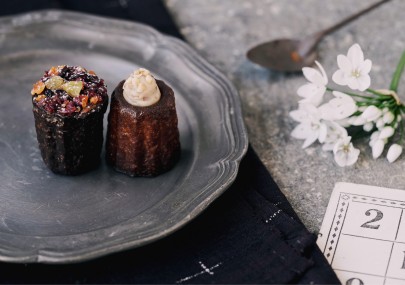
Les canelés de saison | “Chocolat gonomi” et “Chocolat blanc et Raisin sec au rhum”
2月は「ショコラ五ノ実」と「ホワイトチョ…
0Les canelés de saison | “Chocolat gonomi” et “Chocolat blanc et Raisin sec au rhum”
A hint of spring is beginning to drift in the air while the weather remains bitterly cold. February 4th is “Ritsshun”, the first day of spring on the old calendar. “Ritsu “means a beginning and the day used to be New Year’s Day in the old calendar. As the saying goes, “A good beginning makes a good ending”, the beginning of anything is very important. To anticipate a good, peaceful year, it may be a nice idea to fill our hearts with joy and gratitude, and spend a wonderful day of the beginning. Our pair of seasonal canelés for this month, “Chocolat Gonomi” and “White Chocolate and Rum Raisin” are available from today, Thursday, February 1st. The Chocolat Gonomi Canelés are with the Chocolat dough mixed with cranberries. They are decorated with dried fruits: cranberries, green raisins, apricots, and blueberries after being dipped in the ganache mixed with raspberry jam and dressed up with powdered sugar. The bitter-sweet taste of chocolate and the enjoyable texture may be something you might find addictive. The White Chocolate and Rum Raisin Canelés are decorated with white chocolate ganache mixed with chopped rum raisins and crushed peanuts on top while the vanilla-flavored dough is filled with rum raisins too. Please enjoy the rich scent of the rum raisin with the sweetness of white chocolate.
厳しい寒さが残る中、春の気配がほんのり漂いはじめています。2月4日には立春を迎え、暦の上では春になります。「立」には「始まり」の意味があり、古暦では立春こそが新しい1年の始まりでした。「始めよければ終わりよし」という格言もありますが、何事を行うにも最初が大事という意味です。気分よく一年を過ごすため、喜びと感謝で心を満たし、素晴らしい始まりの日を過ごしたいものです。2月の季節のカヌレは「ショコラ五ノ実」と「ホワイトチョコとラムレーズン」が本日2月1日(木)よりお目見えです。「ショコラ五ノ実」はショコラ生地の中にクランベリーを入れ、上にクランベリー・グリーンレーズン・アプリコット・ブルーベリーをラズベリージャムを混ぜたガナッシュにつけてのせ、仕上げに粉糖をふりかけました。チョコレートのビターな味わいと果実の食感をお楽しみください。「ホワイトチョコとラムレーズン」はバニラ生地の中にラム酒漬けのレーズンをたっぷり入れ、上にはラムレーズン入りのホワイトチョコレートのガナッシュを絞り、八ツ割ピーナッツをのせました。甘いホワイトチョコレートのコクにラムレーズンの芳醇な香りがふわりと漂います。
-
Les canelés de saison | “Kurikinton” et “Yuzu”
Happy New Year! Pine trees, an essential for New Year’s decorations, have long been considered sacred trees, said to be “trees that wait for the gods”. The New Year Gods find their way back home by following the evergreen branches of the pine tree. Matsukazari, the pine tree decorations at the entrance are a marker for the New Year Gods to visit each home from above. Furthermore, there are many colors associated with pine tree leaves, such as Chitose-Midori, Tokiwa-Iro, and Oi-Midori. Matsuba-iro has been considered a color of celebration since the Heian period, which was about 1000 years ago. Magically even as winter deepens and the weather turns colder and colder, pine trees continue to show their beautiful colors. Let’s welcome the new year as we cherish the Japanese traditions that have been handed down from ancient times. Our pair of seasonal canelés for this month, “Kuri-kinton” and “Yuzu” are available from the 6th of January. Yuzu canelés are with apricot mixed dough and decorated with our homemade jam using the whole Yuzu on top. The fresh sweetness and sourness of yuzu are concentrated in each canelés. Kuri-kinton canelés are with sweet potato paste made with Japanese Naruto Kintoki inside, decorated with caramelized chestnuts and golden leaves. People eat Kuri-kinton to wish for good wealth. Please enjoy the mild sweetness. Our shops will be back in business from Saturday, January 6th for the New Year. We hope you will enjoy our canelés next year as well!
あけましておめでとうございます。お正月飾りに欠かせない松は「神を待つ木」と言われ、古くから神聖な木とされてきました。年神様は冬でも緑を絶やさない松の枝を頼りに、それぞれの家に帰ってきます。玄関に飾る松飾りは、年神様が地上に降りてくるときに家々を訪れる目印です。また、松の葉にちなんだ色がたくさんあることをご存知ですか?「松葉色」は平安時代からおめでたい色とされ、他にも「千載緑」「常盤色」「老緑」などがあります。冬が深まり、寒さがいちだんと厳しくなっても、変わらず美しい色を見せてくれる松。古来より受け継がれてきた日本の伝統を大切に、新しい年を迎えたいものです。1月の季節のカヌレは 「栗きんとん」と「ゆず」が、1月6日(土)よりお目見えです。「ゆず」は杏の生地に柚子の皮・実・果汁を丸ごと使った自家製ジャムを絞りました。柚子の爽やかな酸味と香りがぎゅっと詰まった一品です。「栗きんとん」は国産のなると金時ペーストのさつまいも餡をたっぷり入れ、栗の甘露煮に金粉を散らしました。お節料理にも欠かせない栗きんとんは金運上昇の願いが込められています。ほくほくやさしい甘さに口元が綻んでしまいます。新年は1月6日(土)からオープンします。今年もよろしくお願いいたします。
-
Les canelés de saison | “Méli-Mélo” et “Noix de coco”
December is on. As soon as we enter December, people start talking about “Bonenkai”, a year-end party. Literally, it translates to a party to forget the year, but it is to forget the hardships of the year to refresh the mind for welcoming the New Year. It is said that the term “Toshiwasure” originates from an event called “Toshiwasure” that was held in the Muromachi period about 500-700 years ago. A diary entry describes how a lively poetry party held at the end of the year for the royal family and aristocrats was associated with the term “Toshiwasure”. It seems that the public enjoyed some gathering events which involved drinking alcohol and dancing wildly. Originally, the “to forget the year” part of the “Bonenkai” word had the meaning of “to forget being old” or “not minding the generation gap”. In recent years, year-end parties have been held by companies and various communities. Therefore, attending them only once but 10 or even 20 times may not be unusual. We wish you all an enjoyable December. Our pair of seasonal canelés for this month, “Meli-melo” and “Coconuts Chocolat” are available from today, the 1st of December. Meli-melo canelés are named after a French word meaning mishmash in English. It is very flavorful and rich with various fruits preserved in rum on top. Coconuts Chocolat canelés are baked with a tablet of roasted shredded coconuts and chocolate inside of the chocolate dough. The white ganache and the coconut powder decoration remind of a White Christmas.
今日から12月。日本では「忘年会」という言葉を見聞きするようになります。その年の苦労は年内に忘れ、新年をすがすがしい気持ちで迎えるために行われる宴会のことです。そのルーツは室町時代に行われていた「としわすれ」という行事からきていると言われています。年末に催された皇族や貴族たちの連歌会が盛り上がり、その様子がまるで「としわすれ」のようだと書かれた日記が残っています。この頃にはお酒を飲んで乱舞する民衆行事も存在していたようです。もともと「忘年」には、「自分が年老いたことを忘れる」や「年齢の差を気にとめない」といった意味合いがあります。近年は会社や様々なコミュニティで開催されている忘年会、人によっては一度に限らず10回20回と顔を出す方も多いのではないでしょうか。みなさまにとって楽しい12月となりますように。12月の季節のカヌレは 「メリメロ」と「ココナッツショコラ」が、本日12月1日(金)よりお目見えです。「メリメロ」はフランス語でごちゃまぜという意味です。ダークラムに漬けた果実がたっぷりのった華やかなカヌレです。「ココナッツショコラ」はココア生地にローストしたココナッツファインとチョコのタブレットをいれて焼き上げ、仕上げにホワイトガナッシュを絞りココナッツパウダーを降らせました。ホワイトクリスマスを想わせる一品です。
-
Les canelés de saison | “Châtaigne” et “Thé et Chocolat Blanc”
As autumn deepens day by day, the falling leaves around our feet catch our eyes. November 8 marks Risshō, the first day of winter, which means that winter has finally arrived according to the calendar. The first season of Risshō is called “Tsubaki hajimete hiraku” meaning “the first opening of sasanqua camellia” in Japanese. In the Chinese character, sasanqua camellia is written as “tea tree that grows and blossoms in the mountains” as their leaves were used for brewing tea in the old days. The flower blooms quietly and prettily in the bleak, wintry season, and is favored as a garden tree in temples and for the tea ceremony. It would be nice to enjoy sasanqua camellia along with the autumn leaves that have begun to change color. Our seasonal canelés for this month, “Chestnuts” and “Tea and White Chocolate” are available from tomorrow, the 2nd of November. Chestnut canelés are filled with chestnut paste and decorated with simmered chestnuts with skin. You can feel autumn in the rich flavor of chestnuts. Tea and White Chocolate Canelés are decorated with tea leaves and white chocolate ganache on top of the dough. Please enjoy the rich flavor in the bergamot aroma of earl gray tea leaves after the tender sweetness of the white chocolate.
日ごとに秋も深まり、足元の落ち葉にふと目が止まります。11月8日には立冬を迎え、暦のうえではいよいよ冬の到来です。11月7日から11月11日に訪れる立冬の初候を「山茶始開(つばきはじめてひらく)」といいます。読みは「つばき」とありますが、ここではツバキ科の山茶花(サザンカ)のことを指します。山茶花という漢字は「山に生え花を咲かせる茶の木」ということで、昔、葉の部分をお茶として飲んでいたことからつけられたそうです。殺風景な冬枯れの季節にひっそりと可憐に咲く山茶花は、寺院や茶室の庭木としても好まれています。色づきはじめた紅葉とともに山茶花の花も楽しみたいものです。11月の季節のカヌレは「栗」と「紅茶とホワイトチョコ」が明日11月2日(木)よりお目見えです。「栗」は栗餡を中まで絞り、栗の渋皮煮をのせて仕上げました。栗の濃厚な味わいに秋を感じる一品です。「紅茶とホワイトチョコ」はアールグレイの生地にホワイトチョコレートのガナッシュを絞り、最後に茶葉をそえました。ホワイトチョコレートのやさしい甘さのあとに広がるベルガモットの風味をお楽しみください。
-
Les canelés de saison | “Citrouille” et “Chocolat aux noix”
We can find autumn deepening as the trees’ leaves change their hue. People often use the phrase “enjoy the long autumn nights,” though the nights are surely longer in winter as autumn nights are generally comfortable and enjoyable for many occasions. It is the time for harvest – it may be a good chance to try cooking new elaborate meals with many ingredients in season and enjoy them with loved ones. Or would you rather immerse yourself in the world of stories by reading books or watching movies? Autumn is a great season to enjoy food, reading, art, and sports. Wish you a fruitful autumn. Our seasonal canelés for this month, “Pumpkin” and “Nuts Chocolat” are available from today, the 1st of October. Pumpkin canelés are decorated with pumpkin seeds with pumpkin paste on top of pumpkin dough. The tender sweetness of pumpkin is concentrated in each canelés and they are perfect for autumn. Nuts Chocolat canelés are with cashew nuts and macadamia nuts in the chocolate dough, decorated with chocolate ganache and dolled up with macadamia nuts. Please enjoy how smooth the chocolate melts in your mouth and the texture of 2 kinds of nuts.
木々の色づきに秋の深まりを感じる季節になりました。「秋の夜長を楽しむ」という言葉をよく耳にしますが、実際には冬のほうが夜は長いのになぜでしょう。それは秋の夜は、過ごしやすく楽しい時間だからです。旬を迎える食材が豊富なので、いつもより手の込んだ料理に挑戦したり、ゆっくりと食事の時間を過ごしたり、読書や映画鑑賞をして物語の世界に浸るのも良いですね。食欲の秋、読書の秋、芸術の秋、スポーツの秋。実り多き秋をお過ごしください。10月の季節のカヌレは「かぼちゃ」と「ナッツショコラ」が、本日10月1日(土)よりお目見えです。「かぼちゃ」はかぼちゃの生地にお手製のかぼちゃ餡をしぼり、かぼちゃの種をのせました。かぼちゃのやさしい甘みがぎゅっと詰まった秋の定番の一品です。「ナッツショコラ」はショコラ生地の中に、カシューナッツとマカダミアナッツを入れ、上にショコラガナッシュを絞りマカダミアナッツをごろっとのせました。チョコレートの口溶けと2種のナッツの食感をお楽しみください。
-
Les canelés de saison | “Patate douce” et “Figues”
The beaming sun finally has started to soften into the gentle autumn sunlight, and as we enter September, the long autumn nights are filled with the chirping of singing crickets. About 1000 years ago, in the Heian era, the aristocrats enjoyed the sound of insects in baskets, and Japanese people have long felt comforted by the sound of insects. The frequency of singing crickets chirping is as high as 4500 Hz, and because of the ratio, the sound doesn’t travel on the phone. It would be nice to enjoy the live performances by the little musicians this autumn. Our pair of seasonal canelés for this month, “Sweet potato” and “Fig” are available from today, September 1st. The sweet potato canelés are candied sweet potatoes wrapped in sweet potato dough and topped with the same filling and sesame sprinkled on top. The sweetness fills your mouth with a soft, luscious flavor. Fig canelés are filled with dried fig compote in red wine and cinnamon-flavored dough. The popping texture of fig and refined afternote of red wine would be delightful.
ギラギラと照りつけていた太陽が、秋のやさしい日差しへと変わりはじめています。9月に入ると秋の夜長に「リーン、リーン」と鈴虫の鳴き声が聞こえてきます。平安時代には、籠に入れた虫の鳴き声を楽しむのが貴族の風流な遊びで、昔から日本人は虫の音にやすらぎを感じてきました。鈴虫の鳴き声の周波数は4500Hzほどと高く、その周波数の関係で固定電話や携帯電話では拾うことができません。小さな音楽家たちの生演奏会に耳を傾けたくなる秋です。9月の季節のカヌレは「さつまいも」と「いちじく」が、本日9月1日(金)よりお目見えです。「さつまいも」はさつまいもの甘露煮をさつまいもの生地で包み、上にものせ、最後にごまを散らしました。さつまいものやさしい甘さがお口いっぱいに広がります。「いちじく」は赤ワインとシナモンの生地の中に、イチジクのコンポートを入れ、上にものせました。イチジクのプチプチ食感と赤ワインの大人な余韻をお楽しみください。
-
Les canelés de saison | “Ananas” et “Fleur de sel de Guérande”
The Dotonbori River Manto Festival is held from July 1 to August 31 along the Dotonbori River, a symbol of Osaka. During that time, the 800-meter promenade from Fukasato Bridge to Nihonbashi Bridge, which locates within a 10-minute walk from Canelé-do Sakuragawa Store, is filled with the bustle of the city and the lights of 1,300 lanterns beautifully and radiating an Osaka summer vibe. Walking along the riverside with a summery atmosphere in the night breeze may be nice. Our pair of seasonal canelés for this month, “Pineapple” and “Salt of Guérande” are available today, August 1st. Pineapple canelés have dried pineapples covered by white sweet bean paste inside, dolled up with homemade fresh pineapple jam on top. This tropical, summery canelé brings out pineapple’s sweet, sour taste. The Salt of Guérande canelés are made with salty dough flavored with “fruits of the sea” or salt of Guérande, France. Please enjoy the fresh afternote spreading as the mild saltiness gently brings out its sweetness.
大阪のシンボル、道頓堀川の遊歩道に約1300の提灯が飾られる「道頓堀川万灯祭」が7月1日~8月31日まで開催されています。カヌレ堂桜川店から徒歩10ほどのところにある深里橋から日本橋までの約800メートル、街の賑わいと提灯の灯りに大阪らしい夏を感じられる風景が広がっています。少し涼しくなった夜に夏の風情あふれる川沿いをお散歩するのもいいですね。8月の季節のカヌレは「パイナップル」と「仏ゲランド産塩」が、本日8月1日(火)よりお目見えです。「パイナップル」はドライパインを白あんで包んだものを中に入れ、生のパイナップルからつくった自家製のジャムを絞りました。パイナップルの甘酸っぱさが引き立つ、トロピカルな真夏のカヌレです。「仏ゲランド産塩」は”海の果実”と呼ばれるゲランド産塩を使った塩生地のカヌレです。まるみのあるしょっぱさが甘さを引き立て、爽やかな余韻が広がります。
-
Les canelés de saison | “Noix de Coco” et “Amande mangue”
July 1st is “Yama-biraki”, the start of the mountain climbing season. Since ancient times, worshiping mountains has been common in Japan as people believed “gods reside in the mountains.” Mountains were considered sacred where only monks and ”Yamabushi”, the mountain priests were allowed to enter and practice asceticism. In modern times, the general public began to enjoy mountain climbing and was allowed to climb the mountains for limited periods of time. “Yama-biraki” is also a ceremony to allow people to go into the mountains and wish climbers safety. The summer mountain season is now in full swing. Our pair of seasonal canelés for this month, “Mango-Annin“ and “Coconut” are available from today, July 1st. Mango-Annin canelés are baked with dried mango put inside of apricot kernel paste. They are adorably decorated with some dried mangos and apricot kernel fondant. The mellow sweetness and sourness might lead you to a tropical getaway. Coconut canelés are with plentiful roasted coconuts mixed in the dough and sprinkled on top. You can almost hear the ocean waves while tasting the canelés.
7月1日は「山開きの日」です。日本では古くから”山に神様が宿る”と考える山岳信仰が盛んで、これらの山は入峰修行をする山伏や僧たちのみの世界で一般の人は立ち入ることのできない聖なる場所とされていました。近世になるにつれ、一般の人も登山を楽しむようになり、限られた期間であれば山に登ることが許されるようになりました。山の神様を祀り、登山中の安全を願うとともに開山をお祝いする山開きは一般の人への入山を許す儀式でもあります。本格的な夏山シーズンの到来です。7月の季節のカヌレは「マンゴー杏仁」と「ココナッツ」が本日7月1日(土)よりお目見えです。「マンゴー杏仁」はドライマンゴーを杏仁餡で包んで焼き上げ、杏仁フォンダンとドライマンゴーをのせました。まろやかな甘みと酸味が南国気分へと誘います。「ココナッツ」は生地にローストしたココナッツを入れ、仕上げにココナッツをまぶしました。波の音が聞こえてきそうな一品をお楽しみください。

